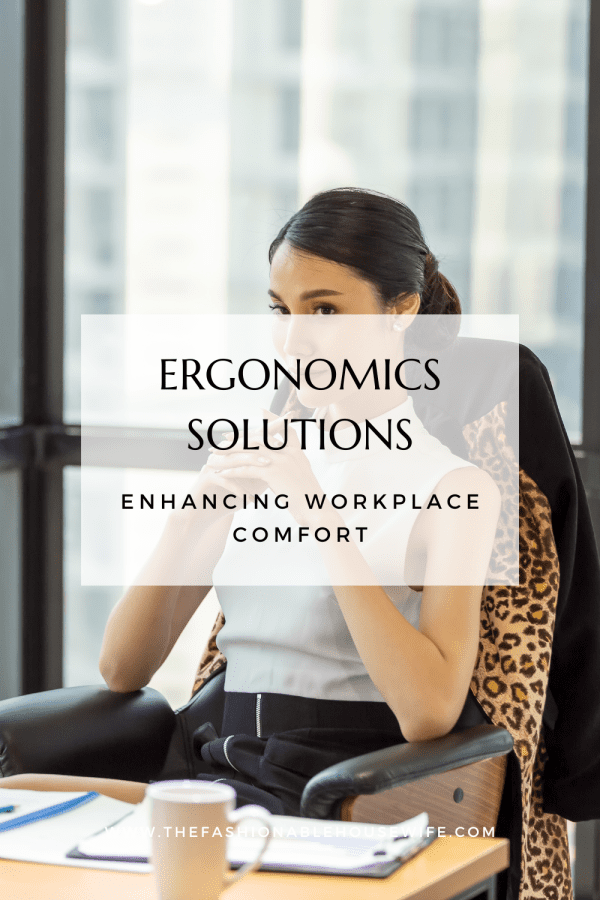
This article explores the topic of ergonomics solutions and their potential to enhance workplace comfort.
It examines the benefits of ergonomic furniture, emphasizing the importance of maintaining proper posture while working.
The discussion also delves into choosing the right desk setup and provides tips for setting up an ergonomic workstation.
Additionally, it offers insights on incorporating movement and stretching into one’s workday to further improve overall well-being.
By adhering to an academic writing style characterized by objectivity, impersonality, and detailed analysis, this article aims to provide knowledgeable and professional information on enhancing workplace comfort through ergonomics solutions.
Benefits of Ergonomic Furniture

The benefits of ergonomics solutions furniture in the workplace include improved comfort, reduced risk of musculoskeletal disorders, and increased productivity.
Ergonomic chair features play a significant role in enhancing comfort and reducing the chances of developing musculoskeletal disorders. These chairs are designed to provide proper support to the body’s natural alignment, with adjustable height and lumbar support to prevent back pain. Additionally, they often have adjustable armrests and seat depth to accommodate different body sizes and promote better posture.
Similarly, ergonomic keyboard design aims to reduce strain on the hands and wrists by positioning them at a neutral angle. This helps prevent conditions like carpal tunnel syndrome and improves typing efficiency.
Importance of Proper Posture
Proper posture plays a critical role in minimizing musculoskeletal discomfort and promoting overall well-being. When sitting for extended periods, maintaining good posture is essential to prevent strain on the muscles and joints.
Sitting ergonomics refers to the science of designing workspaces and furniture that support proper posture and reduce the risk of injury or pain. Ergonomic office chairs are specifically designed to promote correct sitting posture by providing adjustable features such as lumbar support, armrests, and seat height adjustment.
These chairs are designed with ergonomic principles in mind, ensuring that the user’s body is properly aligned while seated. By maintaining proper posture with the help of ergonomic office chairs, individuals can reduce the strain on their neck, shoulders, back, and hips, thus minimizing musculoskeletal discomfort and enhancing overall well-being.
Choosing the Right Desk Setup
Choosing the right desk setup is crucial for maintaining a healthy and ergonomic working environment. One important aspect of a well-designed desk setup is the incorporation of ergonomic desk accessories.
These accessories are specially designed to provide support and comfort to the user, reducing strain on the body during long work hours. Ergonomic keyboard trays, for example, help maintain proper wrist alignment and prevent carpal tunnel syndrome. Adjustable monitor stands allow users to position their screens at eye level, reducing neck strain.
Additionally, standing desk options have gained popularity in recent years due to their potential health benefits. Standing while working can improve posture, increase blood circulation, and reduce the risk of certain health issues associated with prolonged sitting.
Overall, selecting the right combination of ergonomic desk accessories and considering standing desk options can significantly contribute to a healthier and more productive work environment.
Tips for Setting up an Ergonomic Workstation
When setting up an ergonomic workstation, it is important to consider the arrangement of furniture and equipment. Workspace organization plays a crucial role in promoting comfort and productivity.
To create an effective ergonomic workstation, start by placing the desk and chair at appropriate heights to ensure proper alignment of the body. The keyboard should be positioned at elbow height with wrists in a neutral position, which can be achieved using an ergonomic keyboard.
A well-organized workspace should also include easy access to frequently used items such as pens, notepads, and phone. Additionally, it is essential to minimize clutter and maintain a clean working environment to reduce distractions and promote focus.
Incorporating Movement and Stretching Into Your Workday
Incorporating regular movement and stretching exercises throughout the workday can contribute to improved physical well-being and help prevent musculoskeletal issues associated with prolonged sitting.
Active sitting techniques involve using chairs that promote movement, such as those with a swivel or ball design, to engage core muscles and increase blood flow. These techniques can help alleviate back pain and improve posture.
Additionally, desk exercises can be performed during short breaks or while seated at the workstation. Simple stretches for the neck, shoulders, arms, and legs can help relieve tension and reduce the risk of repetitive strain injuries.
It is important to incorporate these movements consistently throughout the day to counteract the negative effects of prolonged sitting on our bodies.



